
Australian nurses have been active participants in disaster assistance both within the in-hospital and out-of-hospital environment. This paper discusses the current disaster education opportunities and challenges for nurses. Additionally, various educational strategies for different cohorts of nurses are discussed highlighting the need for education to be targeted at the right cohort of nurses, at the right time, using the right strategy. To enhance the educational preparedness of Australian nurses and subsequently their willingness to assist in a disaster it is suggested that the education should replicate the realities of `what it is like' to assist in a disaster. Additionally, education should be positioned within a national framework for disaster health education.
A disaster can be broadly defined as an event which results in the interruption of the functioning of a community resulting in the need for external resources to maintain essential services (TFQCDM/WADEM, 2002). One such resource includes the mobilisation of health professionals, including nurses, to provide assistance and maintain or re-establish the day-to-day operational capacity of a health service facility following a disaster event.
Australian nurses have actively participated in disaster assistance1 in both the in-hospital and out-of-hospital contexts in local, national and international environments (Arbon et al. 2006, Grindlay et al. 2010, McArdle 2011, Ranse, Lenson & Aimers 2010, Serghis 1998, Taylor et al. 2003). In Australia, nurses have traditionally assisted during natural or conventional disasters such as extreme weather events and bushfires, while assistance in man-made or non-conventional disasters such as terrorist events has been limited. When a disaster happens, emergency, intensive care and peri-operative areas are commonly affected and, as such, nurses from these specialities assist. It is usually this nursing cohort that participates in out-of-hospital events. In addition, there is an increasing amount of literature highlighting the role of nurses from other specialty areas participating in disaster assistance (Hayes 2011, McArdle 2011).
While there is an increasing amount of literature pertaining to the involvement of Australian nurses in disasters, these accounts are predominately descriptive in nature. However, we do know that Australian nurses have an increased willingness to assist in a disaster if they have completed formal education that includes disaster content (Arbon et al. 2013b, Considine & Mitchell 2009). Therefore, fundamental to the participation of nurses in disaster assistance, is the nurse’s individual educational preparedness.
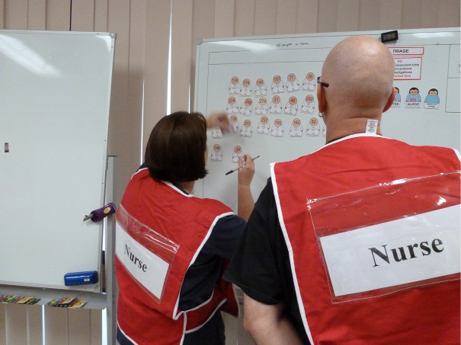
Image: ACT Health
Disaster event exercising in hospitals is an important part of hospital and nursing staff emergency preparations.
This paper explores the current situation regarding the educational preparedness of Australian nurses and the appropriateness of this education. Additionally, this paper comments on future opportunities and strategies for Australian nurses in both the in-hospital and out-of-hospital environment to enhance the educational preparedness of Australian nurses to assist in disasters. Overall, this paper aims to generate discussion regarding the future considerations for Australian nurses and their disaster educational preparedness.
The amount and type of disaster-related content in Australian undergraduate nursing courses is minimal. A recent survey highlighted that only seven out of 19 participating Australian universities had included disaster-related content in their curriculum (Usher & Mayner 2011). Of those, only one covered disaster-related content as a standalone unit while the other six stated that disaster-related content was embedded within other non-disaster specific units (Usher & Mayner 2011). It has been suggested that Australian nursing students could be used in a disaster to support the work of nurses (Cusack, Arbon & Ranse 2010). This notion would therefore require nursing students to have some awareness of the disaster environment.
Four Australian universities currently offer postgraduate courses specific to disaster-related health. However, the disaster-related content within these courses is commonly embedded in a broader global management, humanitarian, or public health focused courses rather than being specific to nursing. Although the disaster-related content of Australian postgraduate nursing courses across different specialties remains unknown, a survey of Australian postgraduate emergency nursing courses identified variation in both disaster-related content and the time dedicated to disaster-related topics in the curriculum (Ranse et al. 2013).
If minimal disaster-related content exists at a tertiary level, this places the onus on health services or hospitals to provide nurses with the education necessary to prepare them for disaster assistance situations (Hammad et al. 2011). Commonly, hospitals in Australia provide education via in-service style education. Anecdotally, hospital in-service style education constitutes topics relating to the day-to-day activities of the environment, such as the latest technologies, management plans, or clinical updates (Hammad, Arbon & Gebbie 2011, Ranse et al. 2013). As such, topics pertaining to disaster situations are likely to receive little attention in in-service education planning. This is a notion supported by research conducted in South Australia which found that approximately half of the emergency nurses surveyed had not received education pertaining to disaster situations in the past 12 months. Additionally, it has been reported that nurses who perceive a decreased level of disaster preparedness attribute these feelings to decreased opportunities for in-service style education (Duong 2009), or decreased experience and exposure to disasters (Hammad, Arbon & Gebbie 2011). It should be noted that the availability and subsequent attendance at disaster education in-services by nurses is unknown and no conclusions regarding the factors which contribute to the decreased participation in disaster-related education can be made. Of significance, when in-service disaster-related education is provided to Australian nurses it has been suggested that this education may not be appropriate or relevant in preparing nurses (Hammad, Arbon & Gebbie 2011).
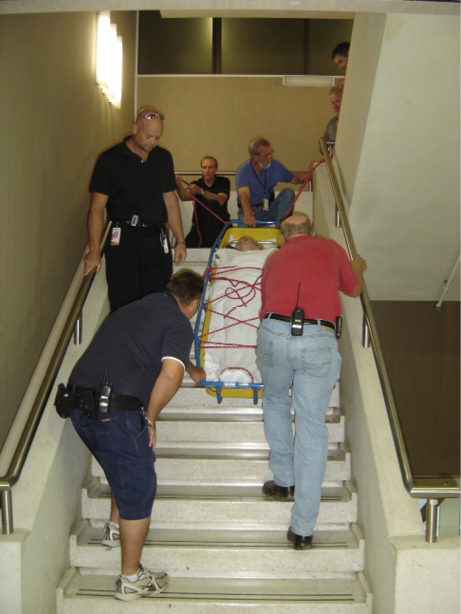
Image: Matt Luther, Calvary Health Care, ACT
A nursing team practice taking a patient down a flight of stairs.
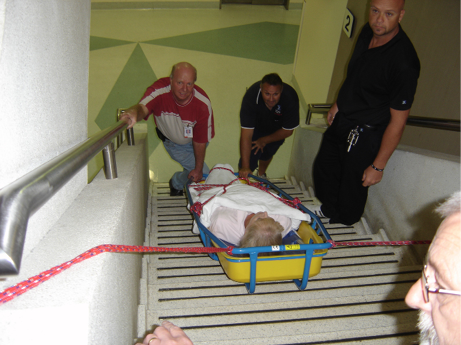
Image: Matt Luther, Calvary Health Care, ACT
A stretcher is secured with ropes as a nursing team manoeuvre it down the stairs.
This discussion highlights the limited availability and appropriateness of disaster-related education for nurses, and implies that disaster preparedness education needs to be sought independently through other avenues. On occasions this may be at the personal expense of nurses themselves. Various Australian organisations and associations provide vocational courses pertaining to disaster-related health such as the Australasian Inter-service Management Systems [AIMS] and Major Incident Medical Management and Support [MIMMS] courses. Additionally, vocational training is commonly offered to nursing members of organisations such as St John Ambulance Australia, the Australian Red Cross, and the Australian Defence Force.
Following deployment to the Sumatra-Andaman earthquake and tsunami in 2004, members of the Australian Disaster Medical Assistance team were invited to participate in a survey about disaster-related education (Aitken et al. 2011). This research highlighted that these health professionals were poorly prepared from an educational perspective. In particular, most participants reported having had no specific education specifically relating to disasters. Of those who had undertaken education specific to disasters, the majority felt that existing education programs, such as MIMMS, did not adequately prepare them for deployment, particularly in relation to aspects of cultural awareness and the use of communications equipment. It has also been suggested that courses which have a pre-hospital focus, such as MIMMS, are arguably limited in the ability to adequately prepare nurses for in-hospital assistance (Hammad, Arbon & Gebbie 2011).
In a study of nurses involved in the disaster assistance to the Black Saturday and Victorian bushfires in 2009 it was highlighted that nurses had participated in mock education related to airport disaster and non-specific mass casualty incidents, yet their disaster assistance experience primarily related to bushfire and extreme weather events. This shows a miss-match between the focus on current disaster-related education for nurses and Australian nurses’ real-life experiences of out-of-hospital disasters assistance (Ranse, Lenson & Aimers 2010). Additionally, research from these bushfires indicated that nurses undertook minimal clinical activities. Instead, their work included psychosocial support, problem solving and care co-ordination; aspects which are often not present in disaster-related education programs (Ranse & Lenson 2012).
There is no doubt that disaster-related education is essential for Australian nurses given their previous involvement in disaster assistance. However, the need for education is often identified in retrospect by those nurses who assist in a disaster with little or no prior disaster-related education or experience.
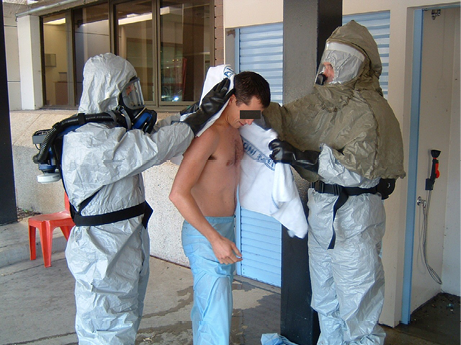
Image: Matt Luther, Calvary Health Care, ACT
Staff wearing breathing apparatus and biohazard suits practice decontaminating a potential victim.
If a disaster occurs within a hospital’s immediate vicinity, it is highly likely that nurses who are employed in that hospital will have a role in assisting in that disaster. This assistance can take many forms from assisting in the emergency department, to evacuating patients from the hospital (Hayes 2011, McArdle 2011). It has been suggested that multi-agency, real-time exercises are rated as highly desirable among Australian nurses to enhance knowledge and understanding of in-hospital disaster assistance (Duong 2009). However, these education experiences are costly and time consuming for exercise planners, the participating agencies and nurses. Alternatively, in-service education has been rated as desirable by nurses for in-hospital disaster-related education (Duong 2009). This approach is less costly and can be conveniently conducted however, the appropriateness of and access to this type of education should be adequately addressed (Duong 2009). Access to this type of education could be solved by introducing e-learning opportunities that can be accessed from any location and on any device.
Nurses deployed to an out-of-hospital disaster situation within their immediate vicinity will, commonly, have minutes to hours to prepare, travel and assist. As such, these nurses rely on the knowledge they have previously received, that is, there is limited to no time for further education and preparation in this type of assistance. For nurses who are likely to assist in out-of-hospital emergency environments, they require education pertaining to the realities of working in the out-of-hospital disaster environment, such as working with fewer resources and working in uncontrolled environments.
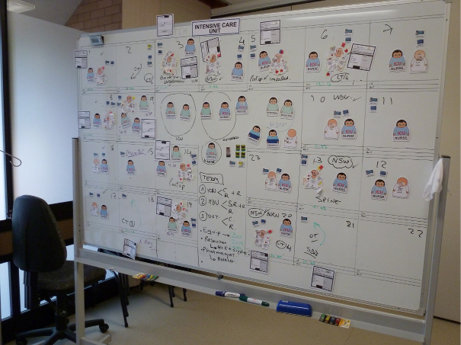
Image: ACT Health
A post-exercise white board displaying key elements of the disaster management exercise.
There is an opportunity for education for nurses who assist during national or international responses as they have a number of hours to prepare, travel and assist. This time provides opportunity for situation-specific education, predominately incorporating principles of just-in-time and mobile education. Just-in-time education approaches have been used internationally to prepare nurses for disasters. This was used effectively in China to educate more than 10 000 people regarding the Sichuan earthquake in 2008 and the H1N1 Influenza outbreak in 2009 (Yang et al. 2010). For Australian nurses just-in-time education could be employed to raise cultural awareness, familiarise nurses with communications equipment, and gain awareness of the current disaster situation and resources available (Aitken et al. 2011).
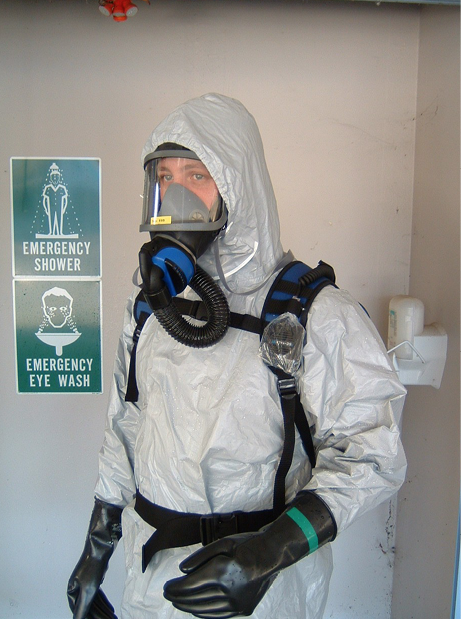
Image: Matt Luther, Calvary Health Care, ACT
Preparing nurses for working in out-of-hospital or hazardous areas, builds a familiarity with these situations and requirements, like working in protective clothing.
Given that disasters are non-discriminatory in terms of their onset, veracity and consequence, nurses and nursing students should have a basic awareness of ‘what it is like to assist’ in a disaster event (Cusack, Arbon & Ranse 2010). This awareness education should include both professional and personal aspects of disaster awareness and preparation to enhance a nurse’s willingness to assist in a disaster (Arbon et al. 2013a, Arbon et al. 2013b). Awareness of local disaster plans and understanding the roles nurses play in local disaster assistance (Duong 2009) are expected to better prepare nurses to quickly respond when emergencies strike. As such, disaster event awareness could be included in undergraduate courses. This would require the uptake of disaster-related content in undergraduate nursing courses. Unfortunately, this content is currently scantly offered (Usher & Mayner 2011). Internet-based programs that include lecture presentations and interactive case studies similar to those developed for the Palliative Care Curriculum for Undergraduates project may be effective in increasing disaster awareness for undergraduates (Hegarty et al. 2010).
A national framework for disaster-related education has been proposed specifically for the Australian context (FitzGerald et al. 2010). This is a multidisciplinary framework that provides guidance for education providers to target disaster-related content at appropriate levels to the appropriate audiences. This framework has seven distinct levels from ‘community information’ to ‘innovation’. These levels consist of education outcomes and recommended content and are aligned to existing recognised education frameworks, such as the Australian Qualifications Framework. It is acknowledged that the proposed national framework is not a curriculum, but a guide to develop programs at various levels (FitzGerald et al. 2010).
This exploration of the educational preparedness of Australian nurses for disaster events has also considered associated challenges surrounding current levels of education. It has highlighted that education opportunities for disaster-related education in Australia are minimal. Having an awareness of the realities of a disaster is important for all responders, nurses included. Further, an Australian nursing workforce that is well prepared for a disaster is more likely and willing to assist during a disaster. Despite the important role of health professionals and nurses in particular, in disaster, the understanding of nurses’ educational preparations for these important events are not well understood. Further research is required to ascertain the appropriateness of various education strategies for nurses in a variety of contexts.
This paper has focused on the disaster-related education of clinical nurses. As such, the educational preparedness of managers, health service executives and other disciplines has not been specifically addressed. Overall, disaster-related education for Australian nurses needs to be targeted at the right cohort of nurses, at the right time, using the right strategy. Strategies include multi-agency real-time exercises, internet-based education, in-service education and just-in-time education. Regardless of which approach is employed the education of nurses should be focused on their likely disaster experience and replicate the realities of such experiences. A national framework is suggested to maintain appropriate standards and provide consistency across Australia that will aid in the mobility of nurses nationally for deployment in times of disaster assistance.
Aitken, P, Leggat, PA, Robertson, AG, Harley, H, Speare, R & Leclercq, MG, 2011, Education and training of Australian disaster medical assistance team members: results of a national survey, Prehospital and Disaster Medicine, Vol. 26, pp. 41–48.
Arbon, P, Bobrowski, C, Zeitz, K, Hooper, C, Williams, J & Thitchener, J, 2006, Australian nurses volunteering for the Sumatra–Andaman earthquake and tsunami of 2004: A review of experience and analysis of data collected by the Tsunami Volunteer Hotline, Australasian Emergency Nursing Journal, Vol. 9, pp. 171–178.
Arbon, P, Cusack, L., Ranse, J, Shaban, RZ, Considine, J, Kako, M, Woodman, R, Mitchell, B, Bahnisch, L & Hammad, K 2013a, Exploring staff willingness to attend work during a disaster: a study of nurses employed in four Australian emergency departments, Australasian Emergency Nursing Journal, Vol. 16, pp. 103–109.
Arbon, P, Ranse, J, Cusack, L, Considine, J, Shaban, R. Z, Woodman, RJ, Bahnisch, L, Kako, M, Hammad, K & Mitchell, B, 2013b, Australasian emergency nurses’ willingness to attend work in a disaster: A survey, Australasian Emergency Nursing Journal, Vol. 16, pp. 52–57.
Considine, J & Mitchell, B, 2009, Chemical, biological and radiological incidents: preparedness and perceptions of emergency nurses, Disasters, Vol. 33, pp. 482–497.
Cusack, L, Arbon, P & Ranse, J, 2010, What is the role of nursing students and schools of nursing during disaster? A discussion paper, Collegian, Vol. 17, pp. 193–197.
Duong, K, 2009, Disaster education and training of emergency nurses in South Australia, Australasian Emergency Nursing Journal, Vol. 12, pp. 86–92.
Fitzgerald, GJ, Aitken, P, Arbon, P, Archer, F, Cooper, D, Leggat, P, Myers, C, Robertson, A, Tarrant, M & Davis, ER, 2010, A national framework for disaster health education in Australia, Prehospital and Disaster Medicine, Vol. 25, pp. 4–11.
Grindlay, J, Young, S, Whitmore, S, Crellin, D, Thomson, BNJ & Julian, MB, 2010, The 2009 Samoan Tsunami—the Victorian disaster medical assistance team deployment, ANZ Journal of Surgery, Vol. 80, pp. 867–869.
Hammad, KS, Arbon, P & Gebbie, KM, 2011, Emergency nurses and disaster response: An exploration of South Australian emergency nurses’ knowledge and perceptions of their roles in disaster response, Australasian Emergency Nursing Journal, Vol. 14, pp. 87–94.
Hayes, B, 2011, Renal dialysis service and patient evacuation during the Queensland Cyclone Yasi disaster, Renal Society of Australasia Journal, Vol. 7, pp. 72–75.
Hegarty, M, Currow, D, Parker, D, Turnbull, B, Devery, K, Canning, D, Nash, R, Mitchell, G, Grbich, C, Yates, P, 2010, Palliative care in undergraduate curricula: Results of a national scoping study, Focus on Health Professional Education; a multidisciplinary journal. Vol. 12, No. 2, pp. 97–109.
McArdle, J, 2011, Cyclone Yasi: dialysis mission impossible, Renal Society of Australasia Journal, Vol. 7, pp. 76–78.
Ranse, J, Lenson, S & Aimers, B, 2010, Black Saturday and the Victorian Bushfires of February 2009: A descriptive survey of nurses who assisted in the pre-hospital setting. Collegian, Vol. 17, pp. 153–159.
Ranse, J & Lenson, S, 2012, Beyond a clinical role: nurses were psychosocial supporters, coordinators and problem solvers in the Black Saturday and Victorian bushfires in 2009, Australasian Emergency Nursing Journal, Vol. 15, pp.156–163.
Ranse, J, Shaban, RZ, Considine, J, Hammad, K, Arbon, P, Mitchell, B & Lenson, S, 2013, Disaster content in Australian tertiary postgraduate emergency nursing courses: A national survey, Australasian Emergency Nursing Journal, Vol. 16, pp. 58–63.
Serghis, D, 1998, After the flood, Australian Nursing Journal, Vol. 5, pp. 16–9.
Taylor, RM, O’Connor, B, St Leone, M & Halpern, JS, 2003, The voice of experience: Australian nurses caring for victims of Bali bombing. Disaster Management and Response, Vol. 1, pp. 2–7.
TFQCDM/WADEM, 2002, Health disaster management: guidelines for evaluation and research in the “Utstein style”, Chapter 3: Overview and concepts, Prehospital and Disaster Medicine, Vol. 17, pp. 31–55.
Usher, K & Mayner, L, 2011, Disaster nursing: a descriptive survey of Australian undergraduate nursing curricula, Australasian Emergency Nursing Journal, Vol. 14, pp. 75–80.
Yang, Y, Chen, Y, Chotani, RA, Laporte, RE, Ardalan, A, Shubnikov, E, Linkov, F & Huang, J, 2010, Chinese Disasters and just-in-time education, Prehospital and Disaster Medicine, Vol. 25, pp. 477–481.
Jamie Ranse has research interests in disaster and mass gathering health. He is completing a PhD exploring the experience of Australian nurse who assist in out-of-hospital disasters. He has an emergency nursing background and is currently an Assistant Professor at the University of Canberra.
Karen Hammad has research interests in the area of emergency nurses and disasters. Karen is currently completing her PhD exploring the experience of nurses who assist in a disaster within the in-hospital context. Karen has an emergency nursing background and is currently a Lecturer at Flinders University.
Kristen Ranse has research interests in the areas of nurse education and end-of-life care in the critical care environment. She has an intensive care nursing background and is currently an Assistant Professor at the University of Canberra.
1 The term ‘disaster assistance’ is used throughout this paper to describe all phases of disaster as Australian nurses participate in disaster assistance across the disaster continuum from disaster prevention to disaster recovery.